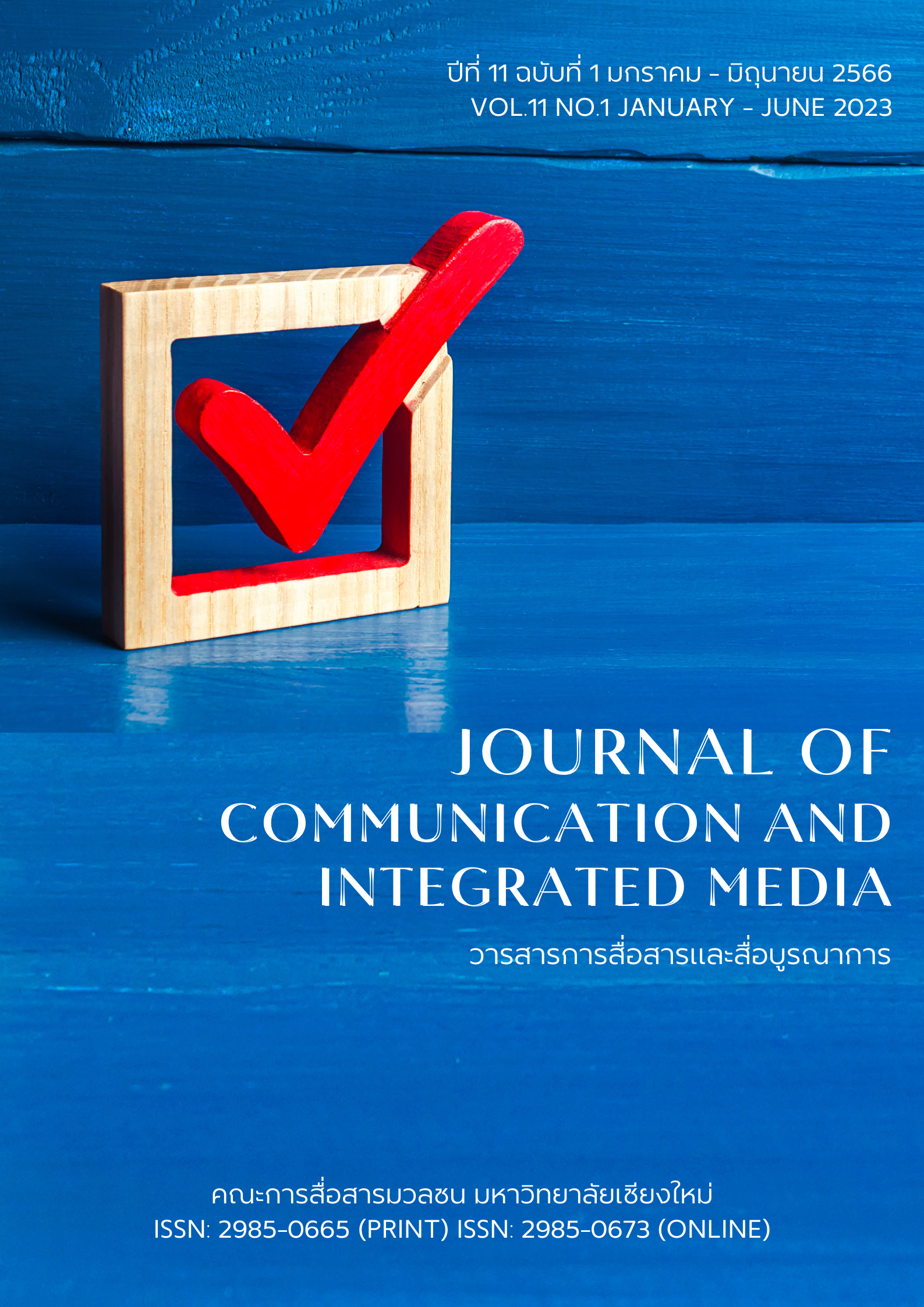กรอบคิดการศึกษาสื่อเสียงในยุคดิจิทัล: จากวิทยุกระจายเสียงสู่ พ็อดคาสต์และการเล่าเรื่องข้ามสื่อ
Main Article Content
บทคัดย่อ
วิทยุกระจายเสียงและพ็อดคาสต์สื่อสารกับผู้รับสารผ่านเสียง แต่ด้วยเทคโนโลยีการสื่อสารสื่อทั้งสองประเภทได้พัฒนารูปแบบเนื้อหา การนำเสนอ การผลิต และการเผยแพร่ที่แตกต่างกัน กรอบคิดการศึกษาพ็อดคาสต์ซึ่งเป็นสื่อเสียงในยุคดิจิทัลจึงควรครอบคลุมทั้งแนวคิดพื้นฐานของสื่อเสียงรวมถึงลักษณะเฉพาะของสื่อยุคดิจิทัล บทความนี้เสนอให้ขยายกรอบคิด PodCred Framework (Tsagkias etal., 2010) ซึ่งรวบรวมตัวชี้วัดพยากรณ์ความมีชื่อเสียงของพ็อดคาสต์ดังนี้ 1) ด้านเนื้อหา ควรศึกษาเนื้อหาที่นำเสนอผ่านการพูดและความสม่ำเสมอของเนื้อหา ควรเพิ่มตัวชี้วัดประเภทเนื้อหาตามหมวดหมู่เนื้อหาของพ็อดคาสต์ 2) ด้านผู้ดำเนินรายการศึกษา วาทะ วิธีการพูด และภาพลักษณ์ 3) บริบทแวดล้อม ศึกษาจากปฏิสัมพันธ์ระหว่างผู้ผลิตกับผู้ฟัง การอยู่รอดทางธุรกิจ และขยายตัวชี้วัดช่องทางการสร้างปฏิสัมพันธ์ที่อาจรวมถึงช่องทางที่เป็นทางการ ช่องทางกลุ่มแฟนสร้างขึ้น สื่อสังคมออนไลน์ พื้นที่สาธารณะออนไลน์ 4) ด้านเทคนิคและการผลิต ศึกษาจากการผลิต ลักษณะผลิตภัณฑ์การเผยแพร่ โดยควรตัดตัวชี้วัดด้านเทคโนโลยีที่ล้าสมัย และเพิ่มตัวชี้วัดรูปแบบการนำเสนอ (format) ของรายการ และท้ายที่สุดควรเพิ่มหมวดหมู่ที่กรอบคิด PodCred Framework ไม่ได้กล่าวถึงคือ 5) ด้านการเล่าเรื่องข้ามสื่อ โดยศึกษาจากการเล่าเรื่องแบบ Transmedia Storytelling และ Cross media Storytelling ของผู้ผลิตพ็อดคาสต์
Article Details

อนุญาตภายใต้เงื่อนไข Creative Commons Attribution-NonCommercial-NoDerivatives 4.0 International License.
ลิขสิทธ์ที่ผู้เขียนบทความต้องยอมรับ
เอกสารอ้างอิง
จุมพล รอดคำดี. (2525). คู่มือการผลิตรายการวิทยุกระจายเสียง. ภาควิชาการสื่อสารมวลชน คณะนิเทศศาสตร์จุฬาลงกรณ์มหาวิทยาลัย.
นภากรณ์ อัจฉริยะกุล และ ธีรารักษ์ โพธิสุวรรณ. (2547) .เอกสารการสอนชุดวิชาการเขียนบทวิทยุกระจายเสียง. มหาวิทยาลัยสุโขทัยธรรมาธิราช.
มหาวิทยาลัยสุโขทัยธรรมาธิราช. (2549). เอกสารประกอบการสอนชุดวิชาการจัดและผลิตรายการวิทยุกระจายเสียงเบื้องต้น. มหาวิทยาลัยสุโขทัยธรรมาธิราช.
สุทิติ ขัตติยะ. (2555). หลักการวิทยุกระจายเสียงและวิทยุโทรทัศน์.ประยูรวงศ์พริ้นท์ติ้ง.
สุทธิรักษ์ วินิจสร. (2545). เรื่องลี้ลับในรายการวิทยุ โทรทัศน์และโทรศัพท์ [วิทยานิพนธ์นิเทศศาสตรมหาบัณฑิต]. จุฬาลงกรณ์มหาวิทยาลัย.
Berry, R. (2016). Part of the establishment: Reflecting on 10 years of podcasting as an audio medium. Convergence: The International Journal of Research into New Media Technologies, 22, 661-671. http://doi.org/10.1177/1354856516632105
Edison Research. (2019). The podcast consumer 2019. https://www.edisonresearch.com/the-podcast-
Gunawardena, D., Karagiannis, T., Proutiere, A., & Vojnovic, M. (2009). Characterizing podcastservices: publishing, usage, and dissemination. Proceedings of the 9th ACM SIGCOMM
conference on internet measurement 2009 (pp.209).https://doi.org/.10.1145/1644893.1644919.consumer-2019/.
Hammersley, B. (2004, Febuary 12). Audible revolution. The guardian, .http://www.theguardian.com/media/2004/feb/12/broadcasting.digitalmedia (accessed April 2019).
Hancock, D. & McMurtry, L. (2018). I know what a podcast is: Post-serial fiction and podcastmedia identity. In llinzres,D., Fox, N., Berry,R. (Eds), Podcasting: New Aural Cultures and Digital Media (pp. 81-105). Palgrave Macmillan. https://doi.org/10.1007/978-3-319-90056-8_5
Kwon, Y. & Byun, D. (2018). An exploration of the limitations of transmedia storytelling: Focusing on the entertainment and education sectors. Journal of Media and Communication Studies. 10. 25-33. http://doi.org/10.5897/JMCS2018.0607.
Miller, C. H. (2014). Digital storytelling: A creator's guide to interactive entertainment (3rdEd.). Focal Press/Elsevier.
Misener, D. (2018, October 26). I analyzed 10 million podcast episodes to find the average length. Pacific content. https://blog.pacific-content.com/how-long-is-the-average-podcast-episode-81cd5f8dff47
Raposo, R. (2022). Podcasts as multimedia and transmedia experiences: A comparative analysis of portuguese and brazilian podcasts.
Visuzl review., 10(3), 1–21. https://doi.org/10.37467/revvisual.v9.3609
Sitthinunt. (2016, October 29). Evergreen content v.s. topical content คอนเทนต์แบบไหนน่าทำกว่ากัน?. https://contentshifu.com/blog/evergreen-content-vs-topical-content
Spinelli, M., & Dann, L. (2019). Podcasting: The audio media revolution. bloomsbury academic.
Tsagkias, M., Larson, M., & De Rijke, M. (2010). Predicting podcast preference: An analysis framework and its application. Journal of the Association for Information Science and Technology. 61, (2) , 374–391. https://doi.org/10.1002/asi.21259


